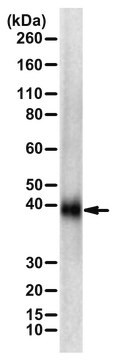MABF2815
Anti-SARS-CoV-2 Spike RBD Antibody, clone 6C2-G9
About This Item
Polecane produkty
pochodzenie biologiczne
mouse
Poziom jakości
białko sprzężone
unconjugated
forma przeciwciała
purified antibody
rodzaj przeciwciała
primary antibodies
klon
6C2-G9, monoclonal
masa cząsteczkowa
calculated mol wt 141.18 kDa
observed mol wt ~200 kDa
reaktywność gatunkowa
virus
opakowanie
antibody small pack of 100 μg
metody
ELISA: suitable
immunoprecipitation (IP): suitable
neutralization: suitable
western blot: suitable
izotyp
IgG1
numer dostępu UniProt
Warunki transportu
dry ice
temp. przechowywania
-10 to -25°C
docelowa modyfikacja potranslacyjna
unmodified
Opis ogólny
Specyficzność
Immunogen
Zastosowanie
Evaluated by Western Blotting in lysate from HEK293T cells expressing full-length spike protein of SARS-CoV-2 virus.
Western Blotting Analysis (WB): A 1:1,000 dilution of this antibody detected Spike glycoprotein in HEK293T cells expressing full-length spike protein of SARS-CoV-2, but not in lysate from wild-type HEK293T cells.
Tested Applications
Neutralizing: A representative lot neutralized SARS-CoV-2 Spike protein RBD to ACE2 in Neutralizing applications (Courtesy of Kento Abe and Anne-Claude Gingras, Toronto).
ELISA Analysis: A 1:3 dilution from a representative lot detected SARS-CoV-2 Spike protein. (Courtesy of Stefan Schüchner, Ingrid Mudrak, Ingrid Frohner, and Egon Ogris (Max Perutz Labs, Medical University of Vienna, Austria).
Western Blotting Analysis: A 1:400 dilution from a representative lot detected Sars-CoV-2 Spike protein in Whole cell lysates of HEK293T cells expressing full-length spike protein of SARS-CoV-2. (Courtesy of Stefan Schüchner, Ingrid Mudrak, Ingrid Frohner, and Egon Ogris (Max Perutz Labs, Medical University of Vienna, Austria).
Neutralizing: A representative lot neutralized SARS-CoV-2 Spike protein RBD binding to ACE2 receptor. (Abe, K.T., et al. (2020). JCI Insight 5(19):e142362).
Immunoprecipitation Analysis: A representative lot immunoprecipitated SARS-CoV-2 Spike protein. (Courtesy of Stefan Schüchner, Ingrid Mudrak, Ingrid Frohner, and Egon Ogris (Max Perutz Labs, Medical University of Vienna, Austria).
Note: Actual optimal working dilutions must be determined by end user as specimens, and experimental conditions may vary with the end user
Postać fizyczna
Przechowywanie i stabilność
Inne uwagi
Oświadczenie o zrzeczeniu się odpowiedzialności
Nie możesz znaleźć właściwego produktu?
Wypróbuj nasz Narzędzie selektora produktów.
Kod klasy składowania
12 - Non Combustible Liquids
Klasa zagrożenia wodnego (WGK)
WGK 2
Temperatura zapłonu (°F)
Not applicable
Temperatura zapłonu (°C)
Not applicable
Certyfikaty analizy (CoA)
Poszukaj Certyfikaty analizy (CoA), wpisując numer partii/serii produktów. Numery serii i partii można znaleźć na etykiecie produktu po słowach „seria” lub „partia”.
Masz już ten produkt?
Dokumenty związane z niedawno zakupionymi produktami zostały zamieszczone w Bibliotece dokumentów.
Nasz zespół naukowców ma doświadczenie we wszystkich obszarach badań, w tym w naukach przyrodniczych, materiałoznawstwie, syntezie chemicznej, chromatografii, analityce i wielu innych dziedzinach.
Skontaktuj się z zespołem ds. pomocy technicznej





